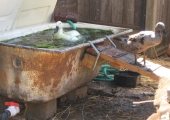We had a problem with our urban homestead in Portland, Oregon. Someone on the block kept calling the city and reporting us for breaking the city ordinance requiring that one's lawn be shorter than 12 inches (which I think has since been repealed). This was both funny and problematic, as we had no lawn. We had 1/3 acre of edible, medicinal, and decorative plants. The ordinance, of course, was designed to keep people from neglecting their properties. In our case, we put exponentially more time into maintaining our property than any of our Kentucky bluegrass neighbors.
The first couple times we got the notice in the mail, we went out to the "yard" and looked around for any obvious things we could trim shorter. The third time it happened, we called the city. An inspector came out and we took them through the property, explaining what all the plants were and their various uses. We were granted a variance, which meant whoever was getting their knickers in a twist could call the city all they wanted and nothing would happen. Had they come talked to us in person, we could have explained to them in person and maybe strengthened a neighborhood connection.
CNN just ran a piece about how more & more people are planting natives in their lawns to conserve water. When de-lawning goes that mainstream, it makes for ample opportunity to bring your friends & neighbors into the fold. You might even see some "weeds" appearing on their lawns.




